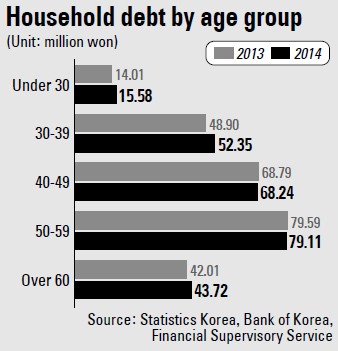Debt highest for people in their 50s

Self-employed people in their 50s had the highest household debt this year, according to a report released yesterday by Statistics Korea.
Statistics Korea, Bank of Korea and the Financial Supervisory Service surveyed 20,000 households nationwide at the end of March in “2014 Household Finance and Welfare Survey Results.”
According to the survey, Koreans aged between 50 and 59 had an average of 79.11 million won ($71,900) of debt, the highest of all age groups. By occupation, people who were self-employed had the highest debt, with an average of 89.95 million won.
Koreans younger than 30 had the least debt, 15.58 million won on average, while those in their 30s had an average of 52.35 million won. Heads of households in their 40s had 68.24 million won of debt and those in their 60s held 43.72 million won in debt.
According to the survey, 53.6 percent of people younger than 30 had some amount of debt, as did 72.9 percent of 30-somethings, 76.1 percent of 40-somethings, 72.2 percent of people in their 50s and 46.8 percent of people aged over 60.
The results showed that seven out of 10 households of people aged 30 to 59 have debt, along with more than half of households aged under 30.
Debt among self-employed people was the highest, averaging 89.95 million won, and 74.4 percent of all self-employed were burdened with debt.
According to the survey, 59.1 percent of all households in Korea are in debt, and 71.8 percent said they were finding it difficult to repay, an increase of 1.6 percentage points from a year earlier.
“Although the interest that households pay has been reduced as interest rates fell last year, the actual proportion of principal payments has increased from last year with low net incomes,” said a spokesman for the Bank of Korea.
As a result, average consumption per household only increased 0.2 percent year-on-year, while average household income increased 4.4 percent from a year earlier.
“Even though their income increases, they spend it paying off interest on mortgages and repayment of principal,” said the spokesman.
According to the survey, average annual consumption per household was 23.07 million won, with spending on food and beverages accounting for the biggest portion at 6.33 million won. Medical expenses increased the most year-on-year, by 6.8 percent.
Among non-living expenditures, spending on pensions and insurance rose 5.7 percent year-on-year.
The survey showed that the amount of household debt increased at a faster rate than the amount of assets owned.
Average assets per household increased 2.1 percent as of the end of March this year over a year earlier, while average debt rose 2.3 percent.
BY KIM JUNG-YOON [kjy@joongang.co.kr]










with the Korea JoongAng Daily
To write comments, please log in to one of the accounts.
Standards Board Policy (0/250자)